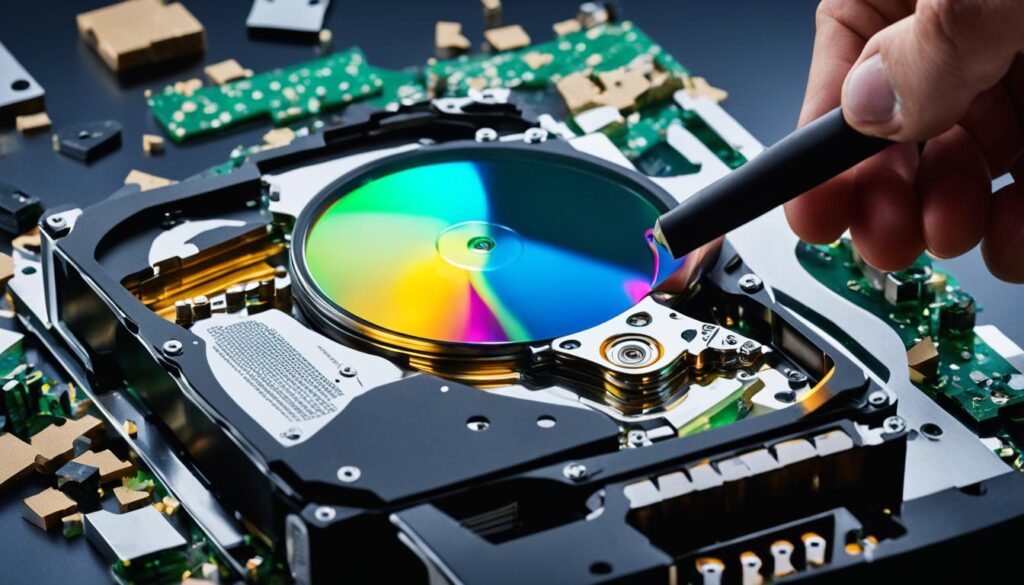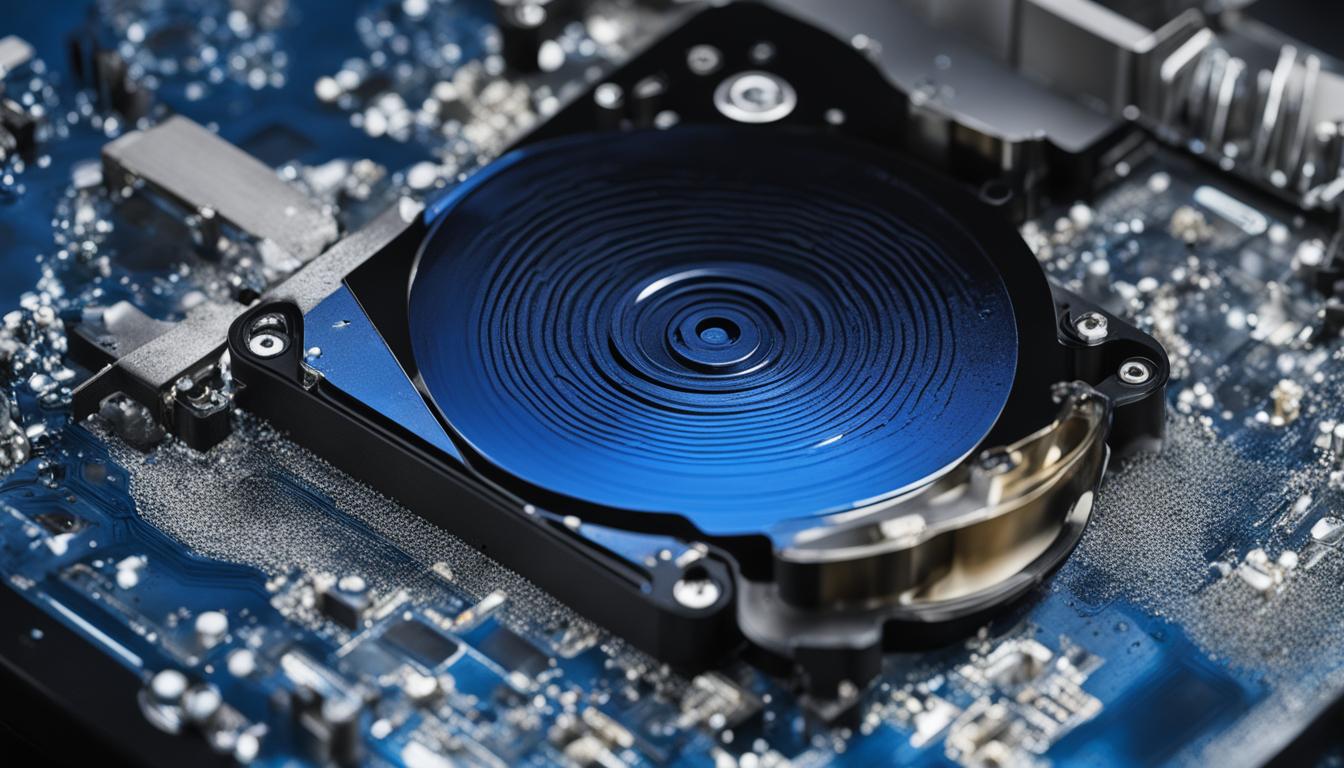Welcome to our article on granular recovery technology! In this section, we will break down the concept and provide a simple explanation of what it is and how it works. Whether you’re an IT professional or simply interested in learning more about data recovery, this article will give you the insights you need.
Contents
Key Takeaways:
- Granular recovery technology allows for the recovery of individual or partial items from backup sets.
- It simplifies disaster recovery and helps maintain business continuity.
- Commonly used in applications like Microsoft Active Directory, Exchange, SharePoint, Hyper-V, and VMware ESXi.
- Works based on object recovery and file/folder recovery methods.
- Offers higher efficiency, greater control, faster recovery times, and cost-effectiveness compared to traditional recovery methods.
How Does Granular Recovery Technology Work?
Granular recovery technology utilizes two main methods: object recovery and file or folder recovery. These methods enable IT administrators to selectively recover specific items, providing a more efficient and targeted approach to data recovery.
“Granular recovery technology allows for the precise restoration of individual files, folders, websites, or even SQL tables based on their names and attributes. It offers a granular level of control over the recovery process, ensuring that only the necessary data is restored.”
Object recovery is commonly used in built-in backup solutions, and it operates by accessing the internal structure or a list of objects used by the software. This method is ideal for recovering data from applications like Microsoft Active Directory, Microsoft Exchange, Microsoft SharePoint, Microsoft Hyper-V, and VMware ESXi.
On the other hand, file or folder recovery is a more generic approach that allows for the recovery of specific files, folders, websites, or SQL tables based on their names and attributes. It offers flexibility in selecting the desired items for recovery, making it suitable for various types of data.
Granular Recovery Technology in Action
Let’s look at a scenario where a company accidentally deletes an important file from its SharePoint server. With granular recovery technology, the IT administrator can quickly locate and restore only the deleted file, saving time and resources.
Here’s an example of how the process works:
- The IT administrator accesses the granular recovery technology tool.
- They select the target SharePoint server and specify the file that needs to be recovered.
- The granular recovery technology tool scans the backup sets, searching for the specific file based on its name and attributes.
- Once the file is found, the IT administrator initiates the recovery process, restoring the file to its original location.
By using granular recovery technology, the company can recover the deleted file without having to restore the entire SharePoint server backup. This not only saves time but also reduces the risk of potential data loss during the restore process.
Granular Recovery Technology in Physical and Virtual Environments
Granular recovery technology is a versatile solution that can be employed in both physical and virtual environments.
In physical environments, the technology operates by directly accessing the backup sets stored on physical media, such as disk drives or tape cartridges. This allows for efficient recovery of individual items without the need to restore the entire backup.
In virtual environments, granular recovery technology works by leveraging the capabilities of virtualization platforms, such as VMware or Hyper-V. It provides the ability to recover specific files, folders, or even entire virtual machines from virtual backups.
The ability to use granular recovery technology in both physical and virtual environments enhances its versatility and makes it a valuable asset for organizations with diverse IT infrastructure.
| Benefit | Description |
|---|---|
| Time Efficiency | Granular recovery technology enables faster data recovery by allowing IT administrators to directly restore specific items without the need to restore the entire backup set. |
| Data Selectivity | IT administrators have granular control over which files, folders, or objects to recover, minimizing unnecessary restores and reducing the risk of data loss. |
| Flexible Recovery | With granular recovery technology, organizations can restore data from various applications and platforms, providing a versatile solution for different recovery scenarios. |
| Reduced Downtime | By swiftly recovering specific items, granular recovery technology minimizes downtime and ensures business continuity. |
Overall, granular recovery technology offers a comprehensive and efficient approach to data recovery. Its ability to recover individual files, folders and objects provides IT administrators with greater control, faster recovery times, and improved productivity.
Traditional Recovery vs Granular Recovery: What’s the Difference?
When it comes to data recovery, understanding the difference between traditional recovery and granular recovery technology is crucial. Traditional recovery methods often involve restoring the entire backup set before finding and recovering specific files, which can be a time-consuming and complex process. On the other hand, granular recovery technology allows for the direct recovery of individual files without the need to restore the entire backup, offering greater efficiency and saving valuable time.
Granular recovery technology is essential in today’s fast-paced digital landscape, where businesses cannot afford downtime and need swift access to critical data. By enabling IT administrators to selectively recover specific files, granular recovery technology streamlines the recovery process and ensures business continuity.
With traditional recovery methods, recovering specific files can be a lengthy and arduous task. IT teams would have to restore the entire backup set, sometimes consisting of terabytes of data, just to find and retrieve a single file. This not only consumes valuable resources but also prolongs the recovery time, leading to potential business losses and productivity setbacks.
Granular recovery technology, on the other hand, offers a more targeted approach. It allows IT administrators to directly recover individual files, folders, or even database tables, eliminating the need for unnecessary restoration. This streamlined process not only saves time but also reduces the complexity of the recovery, making it much easier for IT teams to handle.

With granular recovery technology, you have the power to choose exactly what files you need to recover, minimizing downtime and maximizing efficiency. Whether it’s a critical document, an important email, or a specific database entry, granular recovery puts you in control.
Furthermore, granular recovery technology plays a vital role in ensuring data integrity and minimizing data loss. By enabling the selective recovery of individual files, IT teams can avoid the risk of accidentally overwriting or deleting other data during the restoration process. This adds an extra layer of protection and reduces the potential for human error.
Although traditional recovery methods still have their advantages and are often used alongside granular recovery, it’s clear that granular recovery technology offers significant benefits in terms of time, efficiency, and control. IT professionals and businesses alike can greatly benefit from incorporating granular recovery technology into their data backup and recovery strategies.
| Traditional Recovery | Granular Recovery |
|---|---|
| Restores entire backup set | Directly recovers individual files |
| Time-consuming and complex | Efficient and streamlined |
| Higher risk of data loss or overwriting | Minimizes the potential for errors |
| Used in specific scenarios | Essential for fast and targeted recovery |
Benefits of Granular Recovery Technology
Granular recovery technology offers numerous advantages that make it a valuable tool for data backup and recovery. By leveraging the benefits of granular recovery technology, organizations can enhance their backup processes, minimize downtime, and optimize storage utilization.
Greater Control over Backups and Restoration Processes
One of the key benefits of granular recovery technology is the ability to have greater control over the backup and restoration processes. Unlike traditional recovery methods that require restoring the entire backup set, granular recovery technology allows IT teams to selectively choose which files to recover. This granular level of control ensures that only the necessary data is restored, saving time and storage resources.
Faster Recovery Times Compared to Full Restores
With granular recovery technology, organizations can enjoy faster recovery times compared to full backup restores. Instead of going through the time-consuming process of restoring the entire backup set, granular recovery technology allows for the direct recovery of individual files, folders, or even specific objects within applications. This targeted approach to recovery significantly reduces the downtime associated with data loss and improves overall productivity.
Improved Productivity by Minimizing Downtime
Minimizing downtime is critical for businesses to maintain productivity and customer satisfaction. Granular recovery technology plays a vital role in reducing downtime by enabling the quick restoration of specific files or objects without disrupting the entire system. This means that organizations can rapidly recover critical data and get back up and running in no time, minimizing the impact on operations and ensuring smooth business continuity.
Cost-Effectiveness by Reducing Storage Requirements
Another notable benefit of granular recovery technology is its cost-effectiveness. By allowing for the recovery of individual files or objects, organizations can avoid the need to restore the entire backup set, resulting in significant storage savings. This efficient use of storage resources translates into cost savings for the organization, making granular recovery technology a cost-effective solution for data backup and recovery.

Comparing Benefits of Granular Recovery Technology
| Benefits | Traditional Recovery | Granular Recovery Technology |
|---|---|---|
| Control | Limited control over individual file recovery | Granular control over which files to recover |
| Recovery Time | Lengthy process to restore entire backup set | Quick recovery of individual files or objects |
| Productivity | Downtime during full restore affects productivity | Minimizes downtime by quickly restoring specific data |
| Storage | Requires more storage for full backup restores | Reduces storage requirements by selectively recovering data |
As seen in the table above, granular recovery technology provides clear advantages over traditional recovery methods. Its granular control, fast recovery times, improved productivity, and cost-effectiveness make it a preferred choice for organizations seeking efficient data backup and recovery solutions.
How to Choose Between Traditional Recovery and Granular Recovery
When it comes to data recovery, it’s important to understand the differences between traditional recovery methods and granular recovery technology. The choice between the two depends on the specific needs and requirements of your organization. Let’s explore the factors to consider when making this decision.
Recovery Speed and Data Backup
Granular recovery technology in data backup allows for the quick recovery of specific files, which is crucial in situations where recovering data promptly is essential to prevent significant losses. By selectively restoring only the necessary data, granular recovery technology minimizes recovery times and ensures that your critical files are readily accessible.
Granular recovery technology offers the advantage of fast recovery for specific files, reducing downtime and preventing potential losses. This technology provides a more efficient alternative to traditional full backup restores.
On the other hand, traditional recovery methods involve restoring the entire backup set, which can be time-consuming, especially when dealing with large volumes of data. Business expansion or large-scale workload migration often necessitates the use of traditional full backup and restore methods, as they ensure the comprehensive restoration of all data for an entire system or application.
Efficiency and Cost Implications
Granular recovery technology in data restore offers greater efficiency by enabling administrators to selectively choose which files to recover. This selective approach minimizes downtime and reduces the complexity of the recovery process. By recovering specific files instead of the entire backup set, you can save valuable time and resources.
Furthermore, granular recovery technology helps reduce storage requirements by avoiding the need to restore unnecessary data. This cost-effective approach allows organizations to optimize their storage resources and enhance overall operational efficiency.
However, it’s important to note that traditional recovery methods still have their place in certain scenarios. For instance, when migrating to a new infrastructure or system, traditional full backup and restore methods ensure a seamless transition by restoring all data to its original state.
Considering Your Requirements
When choosing between traditional recovery and granular recovery technology, you need to evaluate your specific needs and goals. Assess the importance of recovering data quickly and efficiently, and consider the potential risks and losses associated with extended recovery times.
If your organization requires the ability to quickly retrieve specific files or objects, granular recovery technology is the recommended choice. Conversely, if you anticipate large-scale migrations or substantial system modifications, traditional full backup and restore methods may be more suitable.
By carefully weighing the efficiency, recovery speed, and cost implications of each method, you can make an informed decision that aligns with your organization’s data recovery requirements.

Conclusion
Granular recovery technology is an invaluable tool in the realm of data recovery, providing superior efficiency, control, and cost-effectiveness compared to traditional methods. With its ability to selectively recover individual files, it eliminates the need for time-consuming full restores, minimizing downtime and maximizing productivity. While traditional recovery methods still have their merits, the advantages offered by granular recovery technology make it an indispensable component of modern backup solutions.
By utilizing granular recovery technology, you gain the power to optimize your data recovery processes. With the ability to pinpoint and restore specific files as needed, you save valuable time and resources, ensuring seamless operation and business continuity. In addition, the reduced reliance on full restores translates to significant cost savings, as you only recover the essential data, reducing storage requirements and minimizing overall expenses.
When evaluating your data recovery options, consider the comprehensive benefits that granular recovery technology brings to the table. Harnessing its granular recovery technology tools enables you to regain control over your backups and restorations, vastly improve recovery times, enhance productivity, and optimize costs. Embrace the potential of granular recovery technology as an indispensable ally in safeguarding your data and ensuring a resilient IT infrastructure.
FAQ
What is granular recovery technology?
Granular recovery technology is a method of recovering data from backup sets that allows for the recovery of individual or partial items.
How does granular recovery technology work?
Granular recovery technology works based on two main methods: object recovery and file or folder recovery.
What are the benefits of granular recovery technology?
Granular recovery technology offers greater control over backups and restoration processes, faster recovery times, improved productivity, and cost-effectiveness.
What is the difference between traditional recovery and granular recovery?
Traditional recovery methods require the restoration of the entire backup set, while granular recovery allows for the direct recovery of individual files without the need to restore the entire backup.
How do I choose between traditional recovery and granular recovery?
The choice between traditional recovery and granular recovery depends on the specific needs and requirements of your organization.




